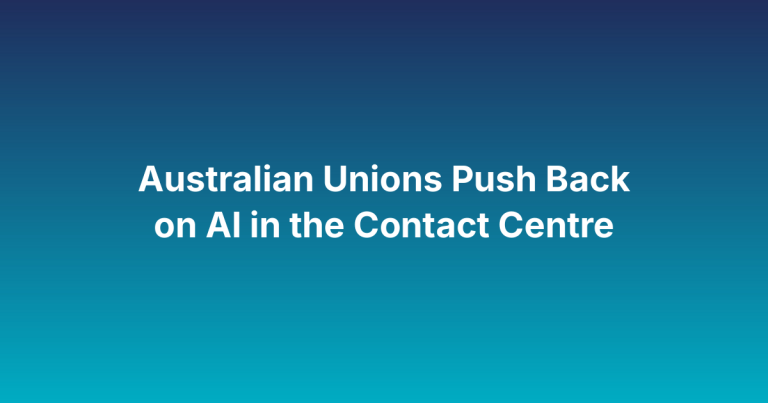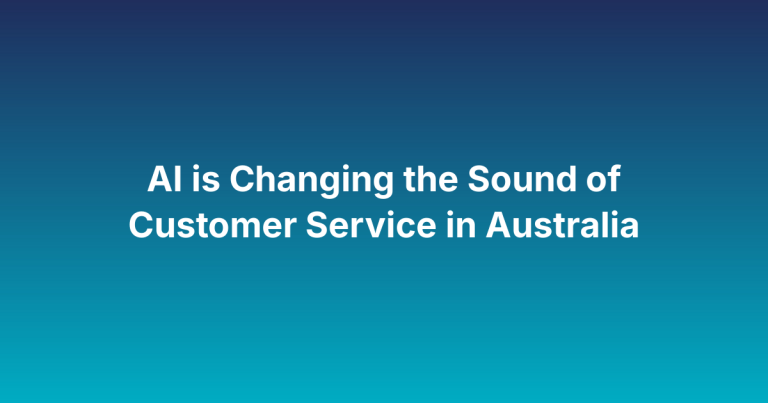The contact centre world is preparing for an important milestone. On 14 November 2025, the new-look Contact Centre Magazine will arrive with features that put it on the map for industry observers and participants alike. This special edition brings a refreshed design as well as critical content, making it an essential read for anyone following contact centre progress and innovation.
The Growing Influence of Australian Unions in Contact Centres
Australian unions have taken a leading role in shaping discussions around AI in contact centres. Their concerns reflect broader anxieties about automation and its effects on workers. In a landscape where artificial intelligence continues to transform contact centre operations, union leaders call for action. At the Productivity Summit, the Australian Council of Trade Unions (ACTU) argues that automation should not undermine worker rights and job security. Their campaign champions legislation to regulate AI, making sure workers have a seat at the table when decisions arise that will shape their professional futures.
The Rise of AI in the Contact Centre Landscape
Artificial intelligence is reshaping the contact centre industry, driving a noticeable shift in how businesses and customers interact across Australia. As technology matures, companies increasingly turn to sophisticated AI solutions, aiming to enhance both efficiency and the overall customer experience. This shift is not simply about faster response times, but also about raising expectations for service quality. Organisations are finding that AI can manage repetitive queries, analyse volumes of data instantly and improve the flow of communication between staff and clients.
In an era where customer experience drives brand loyalty and commercial success, businesses are increasingly re-evaluating how they manage customer engagement. One of the most significant shifts in recent years has been the rise of outsourced contact centres—not just to offshore providers, but to high-performing, onshore specialists.
To understand this evolution, Contact Centre Magazine spoke with Richard Forrest, Chairman of Forrest Contact, an Australian-based contact centre and business process outsourcing (BPO) provider. Forrest, a recognised expert in B2B lead generation and customer service delivery, shares insights on why more businesses are choosing to outsource contact centre operations and how the onshore model is redefining customer engagement.
Traditionally, outsourcing was viewed through a financial lens. Businesses, particularly those in highly competitive sectors such as retail, finance, and telecommunications, sought to reduce operational costs by relocating customer service functions offshore. But as Richard Forrest explains that narrative is changing.
“Organisations are realising that cutting costs at the expense of customer experience is short-sighted,” he says. “Today, businesses are outsourcing for strategic reasons—not just financial ones. They want to provide better customer experiences, improve flexibility, and scale efficiently without sacrificing quality. That’s where onshore contact centres come in.”
According to Forrest, this shift reflects a broader reorientation toward service excellence. “The difference now is that businesses are asking: how can we deliver a better experience, not just a cheaper one?”
While offshore outsourcing still has a place, renewed interest in onshore providers is driven by tangible benefits. There’s more at stake than geography. Language fluency, cultural familiarity, and time zone alignment directly impact service quality and customer satisfaction.
“Language fluency, cultural understanding, and local market knowledge are non-negotiables when your business is committed to delivering a premium customer experience,” says Forrest. “It’s not just about answering the phone; it’s about understanding the customer’s context, nuance, and expectations.”
Onshore contact centres typically deliver faster resolution times, more empathetic interactions, and better customer satisfaction scores. Forrest notes that today’s customers are less tolerant of scripted, impersonal responses that fail to resolve their issues or reflect their tone.
“The post-pandemic customer values connection. When something goes wrong, they want to speak to someone who understands them—not just their problem.”
A growing area of demand is overflow management. Businesses that operate their own customer support teams often perform well—until they’re stretched beyond their limits. Peaks in demand, seasonal surges, or unexpected events can create sudden pressure that in-house teams aren’t equipped to handle.
“We work with companies that are capable under normal conditions, but they hit a wall when things spike,” says Forrest. “It might be a new product launch, a marketing campaign, a system outage, or even just end-of-quarter service requests. That’s where we provide immediate capacity without compromising quality.”
Beyond overflow, Forrest highlights the role of outsourcing in addressing skillset gaps. Some internal teams don’t have the experience required for outbound lead generation, appointment setting, onboarding calls, or complex sales engagement.
download ebook on www.forrestcontact.com.au.
“Sometimes outsourcing isn’t just a stopgap—it’s a strategic enhancement. We bring expertise, systems, and trained people to functions that a business may never specialise in internally.”
Hybrid models are also on the rise. Many businesses are blending in-house teams with outsourced support to balance control, expertise, and scalability. Forrest Contact increasingly works as an extension of internal customer service and sales teams, handling specific segments such as B2B telemarketing, lead generation and qualification, or product support.
“We’re not replacing their team—we’re augmenting it. That’s the distinction,” Forrest says. “Our role is to deliver specialised support, while allowing businesses to focus on what they do best.”
Modern outsourcing is data-driven. Clients now demand visibility, accountability, and performance insights from their contact centre partners. Forrest Contact provides clients with analytics dashboards, call reports, quality assurance feedback and lead conversion tracking.
“Clients want transparency. They want to see what’s working, what isn’t, and where to adjust. That’s exactly how it should be,” Forrest explains. “We’re not a black box—we’re a partner invested in performance outcomes.”
Importantly, Forrest sees outsourcing not merely as an operational tool but as a growth enabler. Businesses are increasingly bringing contact centre strategy into their broader commercial planning, viewing it as a lever to drive sales, deepen loyalty, and optimise resources.
“Outsourcing is no longer the domain of reactive decision-making. It’s part of the business development strategy,” Forrest notes. “We’ve moved from the cost centre mindset to value creation.”
Despite the widespread adoption of automation and AI tools, Forrest is confident that human interaction remains irreplaceable in the contact centre environment. He sees AI as an enabler, not a substitute.
“AI has a valid role, particularly in back-office and self-service channels. But when it comes to persuasion, empathy, negotiation, and problem-solving, people want to deal with people. That human conversation still matters.”
In fact, he believes that as consumers become increasingly weary of automation, human engagement will become a differentiator.
“We’re already seeing pushback from customers who feel dehumanised by chatbot loops and scripted workflows. When they’re spending money or facing a problem, they want to feel heard.”
As Forrest Contact continues to grow its service offerings and client base, Forrest sees the future of contact centre outsourcing being anchored in three pillars: specialisation, flexibility, and measurable performance. And it’s clear that the businesses embracing these values will be the ones delivering customer experiences that go beyond service to drive long-term loyalty and commercial success.
HCLTech and Microsoft are taking customer service innovation to the next level by strengthening their strategic partnership. Together, they are set to transform contact centres using cutting-edge generative AI and cloud solutions. This collaboration promises to redefine customer interactions, making them faster, smarter, and more personalised.
Driving Innovation in Contact Centres with Generative AI
As part of this initiative, HCLTech will become the exclusive professional services partner for the existing Nuance Enterprise Professional Services contracts, a Microsoft unit until January 2024. This shift marks a major milestone in their collaboration and will see more than 550 Nuance employees join the HCLTech team, further enhancing its expertise in the rapidly growing Contact Centre as a Service (CCaaS) market.
To facilitate this transition, HCLTech is launching a “Nuance Migration Factory,” a dedicated program designed to migrate Nuance’s advanced contact centre solutions to Microsoft Dynamics 365 Contact Centre. By adopting Dynamics 365 as its preferred platform, HCLTech aims to provide businesses with a seamless integration of professional services, self-service applications, and AI-driven tools like Microsoft Copilot.
A Partnership Shaping the Future of Customer Experience
The partnership also includes a comprehensive suite of services, such as system integration, application development, and migration support, all underpinned by AI transformation expertise. This robust offering is designed to help businesses adopt next-generation tools and provide a superior customer experience.
Anil Ganjoo, Chief Growth Officer for the Americas at HCLTech, highlighted the company’s dedication to driving innovation, saying that HCLTech is taking a significant step forward in leading AI-powered advancements within the expanding CCaaS market. He further emphasised that the collaboration with Microsoft reflects a mutual commitment to enhancing customer experiences through cutting-edge technology solutions.
Sharing similar excitement, Charles Lamanna, Microsoft’s Vice President for Business and Industry Copilot, praised the strengthened collaboration with HCLTech. He noted that the partnership aligns with their shared goal of utilising AI to revolutionise the CCaaS industry, emphasising that this joint effort is setting the foundation for a transformative era in customer service.
HCLTech, a global leader in technology services, employs over 220,000 people across 60 countries. For the year ending December 2024, the company reported impressive consolidated revenues of USD 13.8 billion. With expertise spanning digital transformation, engineering, cloud computing, and AI, HCLTech serves industries ranging from financial services and healthcare to manufacturing and telecom.
This partnership highlights the increasing role of artificial intelligence in reshaping industries worldwide. By combining HCLTech’s global reach and technological expertise with Microsoft’s advanced AI capabilities, the two companies are setting the stage for a smarter, more efficient future for customer service.
Transforming Customer Service with AI and Cloud Solutions
For businesses, the integration of AI-powered tools into contact centres offers immense potential. From automating repetitive tasks to providing hyper-personalised customer support, these solutions are designed to save time, reduce costs, and improve satisfaction. For customers, it means quicker resolutions, more accurate assistance, and a seamless service experience.
As the partnership unfolds, businesses and customers alike are eager to see how these innovations will transform their day-to-day interactions. It’s clear that the future of customer service is here, and it’s being shaped by the combined efforts of HCLTech and Microsoft.
What’s your take on AI stepping into the customer service space? Do you believe these advancements will create a better experience, or do you still prefer the personal touch of human interaction?
Telstra is taking a bold step to strengthen connectivity in Australia with its latest partnership with SpaceX. The telecommunications leader announced an agreement to utilize SpaceX’s Starlink satellites to trial satellite-to-mobile services. The initiative begins this year with text messaging capabilities addressing Australia’s connectivity challenges.
The initial phase of the partnership focuses on enabling SMS functionality on compatible devices, with a commercial rollout planned once the trials are completed. While the current scope is limited to text messaging, Telstra has ambitious plans to expand the offering. The company plans to include voice and low-speed data services in future developments. This will eventually ensure that smartphones across Australia can connect, even in the most remote locations.
Shailin Sehgal, Telstra’s group executive of global network and technology, identified the critical role this technology will play in Australia’s vast and challenging terrain. “Australia’s landmass is vast, and there will always be large areas where mobile and fixed networks do not reach. This is where satellite technology will play a complementary role to our existing networks,” he explained. With Starlink covering most of the country, the initiative will greatly improve mobile access across Australia.
Currently, Apple iPhone 14 and newer models can utilize Starlink for Emergency SOS mode, allowing users to send text messages to emergency services via Globalstar satellites. Telstra’s new satellite-to-mobile service goes beyond emergencies. It lets users send SMS to anyone within Starlink’s coverage.
Telstra’s relationship with Starlink is not new. In 2023, the telco signed an agreement with Elon Musk’s company to provide Starlink-powered home broadband and voice services for residential and small business customers. Its Satellite Home Internet service launched last year, giving Telstra a strong presence in the satellite broadband space.
The move to satellite-to-mobile services builds on Telstra’s earlier achievements and follows a comparable collaboration between SpaceX and Optus. Optus had previously announced plans to launch satellite-to-mobile SMS in 2024, with voice and data services to follow in 2025. As competition intensifies, Telstra’s partnership with Starlink signals its determination to lead in satellite-enabled connectivity.
This initiative highlights the growing importance of satellite technology in overcoming the challenges posed by Australia’s expansive and often remote geography. Telstra’s approach extends mobile connectivity to underserved areas benefiting individuals, businesses, and emergency services alike.
As trials begin this year, attention will turn to Telstra and SpaceX to see how this innovative partnership influences the future of connectivity in Australia. For customers, it represents a step closer to effortless communication, no matter where they are. For the telecommunications industry, it’s a glimpse into the exciting possibilities of satellite-to-mobile technology.
The Commonwealth Bank is making waves by testing a new AI-driven chatbot named “Hey CommBank.” This cutting-edge tool, inspired by ChatGPT, is currently being trialed by the bank’s employees, who are also customers. It’s a bold step that could change how customer service works while sparking conversations about the future of jobs in the banking sector.
Currently, the Commonwealth Bank employs around 2400 call centre staff who handle up to 50,000 customer calls daily. These employees provide essential support, assisting with everything from account inquiries to complex financial questions. Introducing an AI chatbot like Hey CommBank could reshape this dynamic, offering an alternative way to interact with customers.
The chatbot has been designed to provide answers in a conversational and approachable manner, drawing from the bank’s extensive data. For instance, it could guide customers on how much they need to save to achieve their dream of owning a home or address common financial queries quickly and efficiently.
This trial is part of the bank’s more significant push into artificial intelligence, supported by Amazon’s AI Factory. The bank recently became the first in Australia to use this state-of-the-art technology, which allows for safe testing and development of AI solutions. The goal is to ensure these tools are effective and responsible before rolling out on a broader scale.
Andrew McMullan, the bank’s Chief Data Officer, highlighted the importance of this approach. He explained that the chatbot is being evaluated to ensure it can engage effectively with customers while maintaining high safety standards. For the bank, it’s not just about efficiency but also about improving the overall customer experience.
Artificial intelligence is already being used behind the scenes at Commonwealth Bank to monitor service calls. These calls can now be transcribed in just over a second, and the AI evaluates customer sentiment to provide insights for service improvements. While this technology is a valuable asset, the move toward deploying an AI chatbot raises questions about the future of call centre jobs.
For now, the bank has been careful to position Hey CommBank as a tool for enhancement rather than replacement. It aims to offer hyper-personalised and context-aware services, giving customers more tailored support than ever before. However, advancements like these could reshape the landscape of customer service in banking and across various industries.
As the trial continues, Australians watch closely to see how this new technology will unfold. Will it deliver the efficiency and convenience customers crave, or will it leave some longing for the familiar human touch? One thing is sure – the future of banking is evolving rapidly, and it’s an exciting time to witness these changes firsthand.
What do you think about AI stepping into the world of banking? Would you trust a chatbot to handle your financial questions, or do you prefer the personal touch of a real person?
Bendigo Bank is reaping the rewards of its transition to Amazon Web Services’ (AWS) Connect platform, reporting significant gains in customer service efficiency and satisfaction since migrating its contact centre operations to the cloud-based solution in late 2023. The shift has driven a 90 per cent reduction in call wait time complaints and a 46 per cent drop in internal call transfers, contributing to a 20 per cent overall boost in customer service efficiency. These improvements have helped Bendigo achieve a 17 per cent year-on-year increase in its Net Promoter Score (NPS), which now stands at +19.7 as of June 2024, according to Roy Morgan. This positions Bendigo as Australia’s second-highest-rated major bank for customer satisfaction, just behind ING at +25.3.
In November 2023, Bendigo completed a six-month migration to AWS Connect, consolidating its contact centre from a fragmented mix of legacy on-premises applications to a unified, scalable platform. The transition has delivered what the bank describes as “greater agility, reliability, and operational efficiency” for its contact centre team, which handles over one million customer calls annually. AWS Connect’s suite of tools has proven instrumental in driving these outcomes. The platform’s advanced analytics, fraud detection capabilities, generative AI, and machine learning-powered insights are helping Bendigo’s contact centre team optimise operations and enhance customer interactions. Notably, the system generates post-contact summaries, tracks customer sentiment, and provides near-real-time dashboards. These features empower agents with a complete view of customer interactions while enabling leaders to identify performance trends and areas for improvement.
According to Megan Papadopoulos, General Manager of Customer Contact at Bendigo Bank, the transition to AWS Connect has transformed the way the team leverages data. “This program of work is now arming our people and leaders with all the intelligence needed to make decisions quickly, act with confidence and deliver results for customers,” she said. The bank has seen a notable reduction in average handling time, allowing staff to focus on enhancing the overall customer experience. With streamlined call flows, effective call tagging, and better utilisation of call reason data, Bendigo is positioning itself for a new wave of customer-focused initiatives.
The benefits of AWS Connect extend beyond Bendigo’s contact centre, with over 50 teams across various divisions now using the platform. These wholesale improvements are driving efficiency across the organisation, contributing to an enhanced service offering for all customers. Looking ahead, Bendigo plans to further reduce friction points, such as on-hold wait times and cumbersome identification processes. The bank aims to continue leveraging its AWS-powered insights to refine customer experiences and adapt to evolving expectations.
Bendigo Bank’s investment in AWS Connect underscores its commitment to innovation and customer service excellence. By integrating advanced technologies into its operations, the bank is not only enhancing its immediate service delivery but also setting a new benchmark for how Australian banks can leverage technology to build deeper, more meaningful connections with their customers. As customer expectations evolve, Bendigo Bank’s data-driven approach and ability to adapt quickly place it in a strong position to maintain its leadership in customer satisfaction. With the groundwork laid, the bank is well-equipped to achieve even greater efficiencies and continue delivering exceptional service to its growing customer base.
For years, Microsoft had been cautiously navigating the contact centre space, focusing on enhancing its CRM offerings and integrating third-party solutions via Microsoft Teams. Its previous venture, the Microsoft Digital Contact Centre Platform, offered a framework for integrations but lacked the comprehensive capabilities needed to dominate the market.












